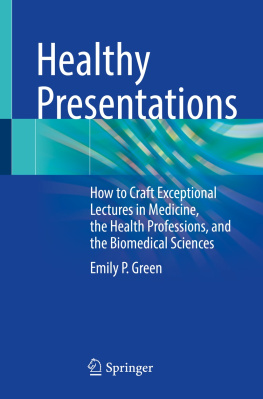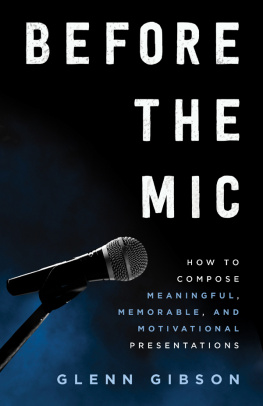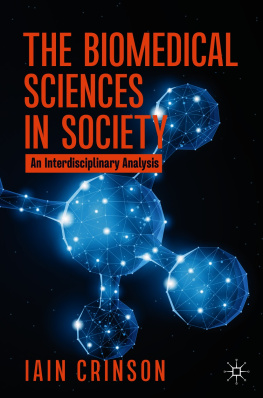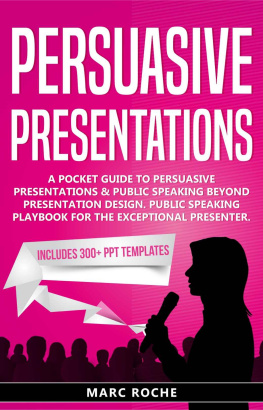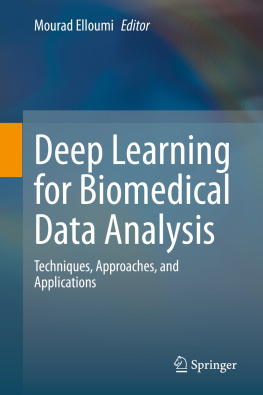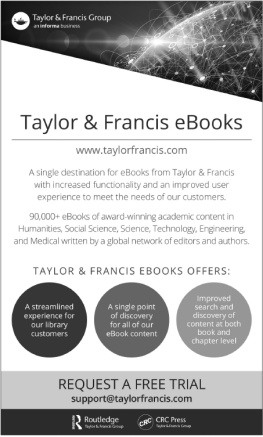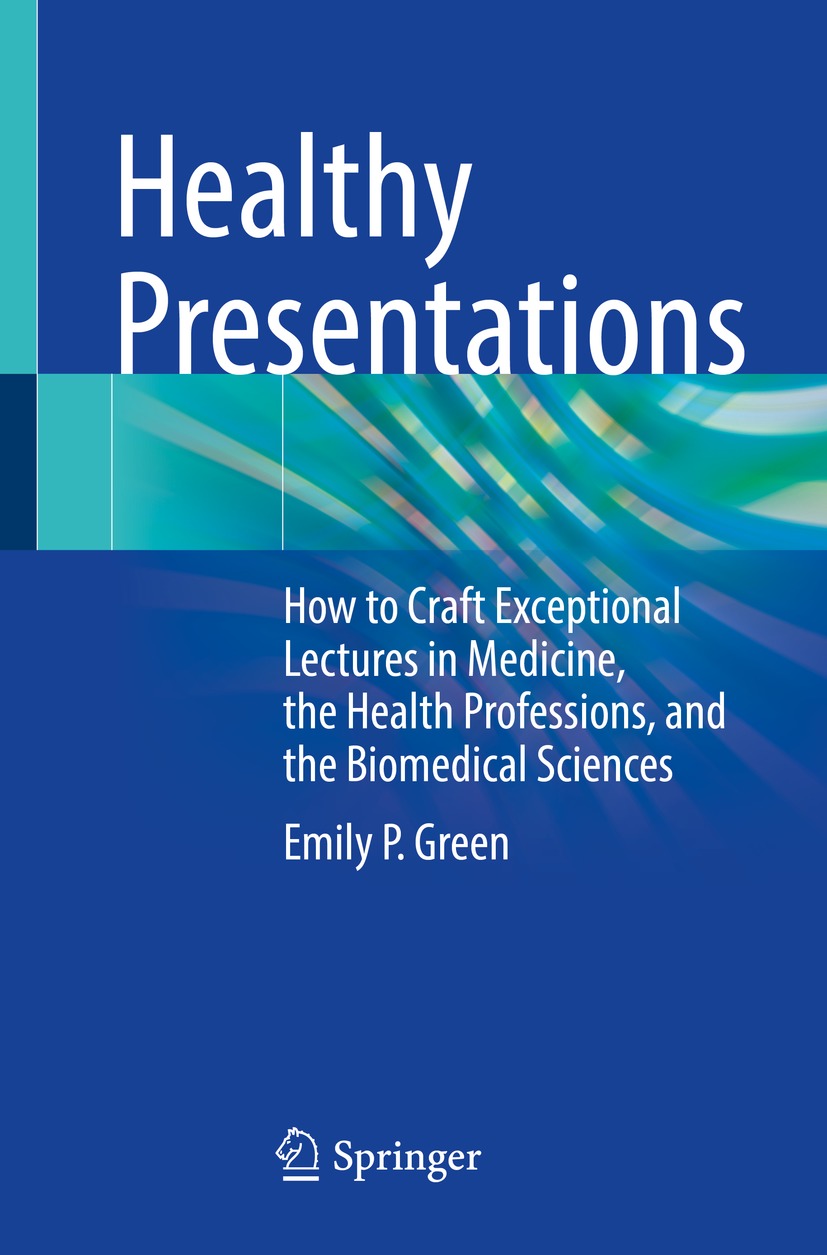Emily P. Green
Healthy Presentations
How to Craft Exceptional Lectures in Medicine, the Health Professions, and the Biomedical Sciences
1st ed. 2021

Logo of the publisher
Emily P. Green
The Warren Alpert Medical School of Brown University, Providence, RI, USA
ISBN 978-3-030-72755-0 e-ISBN 978-3-030-72756-7
https://doi.org/10.1007/978-3-030-72756-7
The Editor(s) (if applicable) and The Author(s), under exclusive license to Springer Nature Switzerland AG 2021
This work is subject to copyright. All rights are solely and exclusively licensed by the Publisher, whether the whole or part of the material is concerned, specifically the rights of translation, reprinting, reuse of illustrations, recitation, broadcasting, reproduction on microfilms or in any other physical way, and transmission or information storage and retrieval, electronic adaptation, computer software, or by similar or dissimilar methodology now known or hereafter developed.
The use of general descriptive names, registered names, trademarks, service marks, etc. in this publication does not imply, even in the absence of a specific statement, that such names are exempt from the relevant protective laws and regulations and therefore free for general use.
The publisher, the authors and the editors are safe to assume that the advice and information in this book are believed to be true and accurate at the date of publication. Neither the publisher nor the authors or the editors give a warranty, expressed or implied, with respect to the material contained herein or for any errors or omissions that may have been made. The publisher remains neutral with regard to jurisdictional claims in published maps and institutional affiliations.
This Springer imprint is published by the registered company Springer Nature Switzerland AG
The registered company address is: Gewerbestrasse 11, 6330 Cham, Switzerland
Foreword
Is lecturing a thing of the past? Not if you do it right and focus on facilitation of learning instead of simple information transfer! As a medical educator for 30 years, and as someone who has observed countless lectures by medical faculty in my role in overseeing medical school curriculum, I am extremely excited that Dr. Emily Greens Healthy Presentations has come to fruition. This book fills a need for a concise, practical guide rich with examples and options for medical educators who are short on time but inspired to improve teaching and clarity of communication with learners.
Other available resources are typically written for the business, marketing, and corporate worlds. They do not address the specific needs of teaching in the health professions namely complex and content-heavy presentations and many are outdated. I have attended many of Dr. Greens faculty development workshops and lectures over the past decade and I always learn something new. Dr. Green has extensive experience in faculty development and has hands-on experience working directly with medical faculty in improving their presentations. She is an articulate and masterful communicator. Her educational background, experience in medical education, and honed skills in giving faculty feedback on their presentations make her uniquely suited to addressing the need for an up-to-date, concise, well-written guide for medical educators.
Dr. Green shares her skills in faculty development with the medical and health professions community in Healthy Presentations. Whether you are just beginning to craft new lectures, or you have been doing this for a long time, I am certain you will find invaluable advice and concrete examples in this book that you will be able to readily put into action.
While the national trend in medical education is directed away from traditional lecturing, I would argue, as Dr. Green does in this book, that well-designed, increasingly interactive, and clearly communicated presentations are here to stay. The changes in medical education that have been accelerated by the COVID-19 pandemic starkly outline the challenges of distant, depersonalized learning. In a very timely chapter, Dr. Green addresses ways to actively engage learners in virtual and asynchronous teaching modules.
In another timely chapter, Dr. Green outlines approaches that medical educators can use to assure that their presentations are inclusive and anti-racist. Dr. Green has been working closely with our medical faculty in putting these approaches into practice. She shares this expertise in a straightforward practical fashion using concrete examples. This unique perspective will be much appreciated by medical educators seeking to develop inclusive teaching and learning materials.
I learned much of what I know over the years by teaching and observing faculty members, fine-tuning the art of interactive teaching. I wish a guide like this had been available to me when I was starting out. I learned the hard way by trial and error the latter of which is far less beneficial to our learners. Dr. Green has accumulated a wealth of knowledge that she shares in Healthy Presentations that will be extremely helpful to medical educators. Enjoy!
Luba Dumenco, MD, MEHP, FACPAssociate Professor of Medical ScienceThe Warren Alpert Medical School of Brown UniversityProvidence, RI, USA
Luba Dumenco
Acknowledgments
I owe an enormous debt of gratitude to the medical faculty of The Warren Alpert Medical School of Brown University with whom I have worked over the last 15 years. Thank you for granting me the privilege of watching your presentations, and for being brave and vulnerable enough to allow me to critique them.
A special thank you to Dr. Luba Dumenco for granting me extraordinary access to her lecture content. She is an outstanding educator and a highly talented presenter who has won many teaching awards over the years. This book would not be possible without her.
Thank you to Drs. Kristina Monteiro, Robert Tubbs, Allan Tunkel, and Jordan White for access to their lecture and scholarly content.
Thank you to Dr. Jason Hack for the presenter as Instagram star metaphor used in Chap..
Thank you to Dr. Wael Asaad for the mushroom metaphor used in Chap. , Example 5.24.
Thank you to Dr. Angela Anderson for the slide sorter tip mentioned in Chap..
A big thank you to Philip G. Rickards, the original presenter!
Finally, all my love to Bob, Charlotte, Alice, and Leo Green, my extraordinarily supportive husband and three wonderful children.
References
Acquaviva KD, Mintz M. Perspective: are we teaching racial profiling? The dangers of subjective determinations of race and ethnicity in case presentations. Acad Med. 2010;85(4):7025.
Alley M. The craft of scientific presentations: critical steps to succeed and critical errors to avoid. 2nd ed; 2013.
Anderson LW, Bloom BS. A taxonomy for learning, teaching, and assessing: a revision of Blooms taxonomy of educational objectives. Longman; 2001.
Anderson MR, Moscou S, Fulchon C, Neuspiel DR. The role of race in the clinical presentation. Family Medicine-Kansas City. 2001;33(6):4304.
Atkinson C. Beyond bullet points: using Microsoft PowerPoint to create presentations that inform, motivate, and inspire (Bpg-other). Microsoft Press; 2005.

